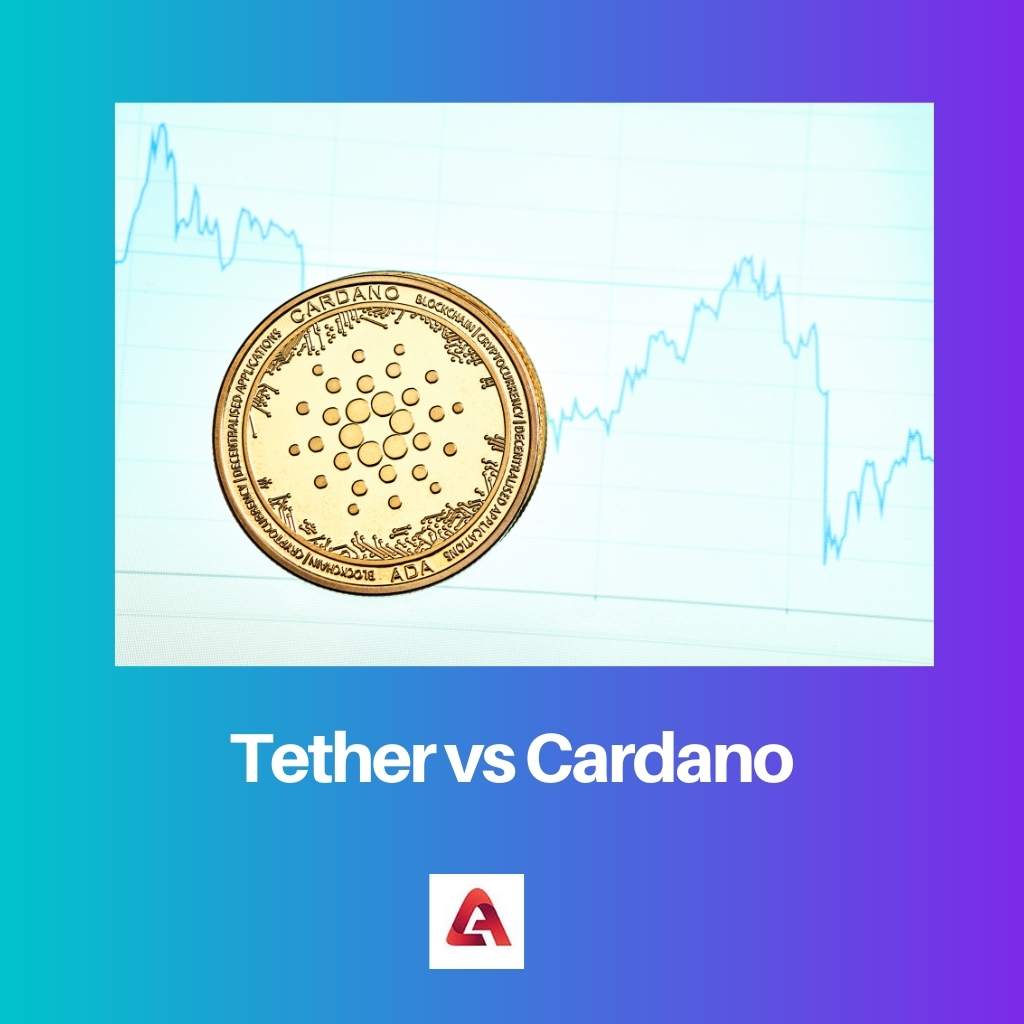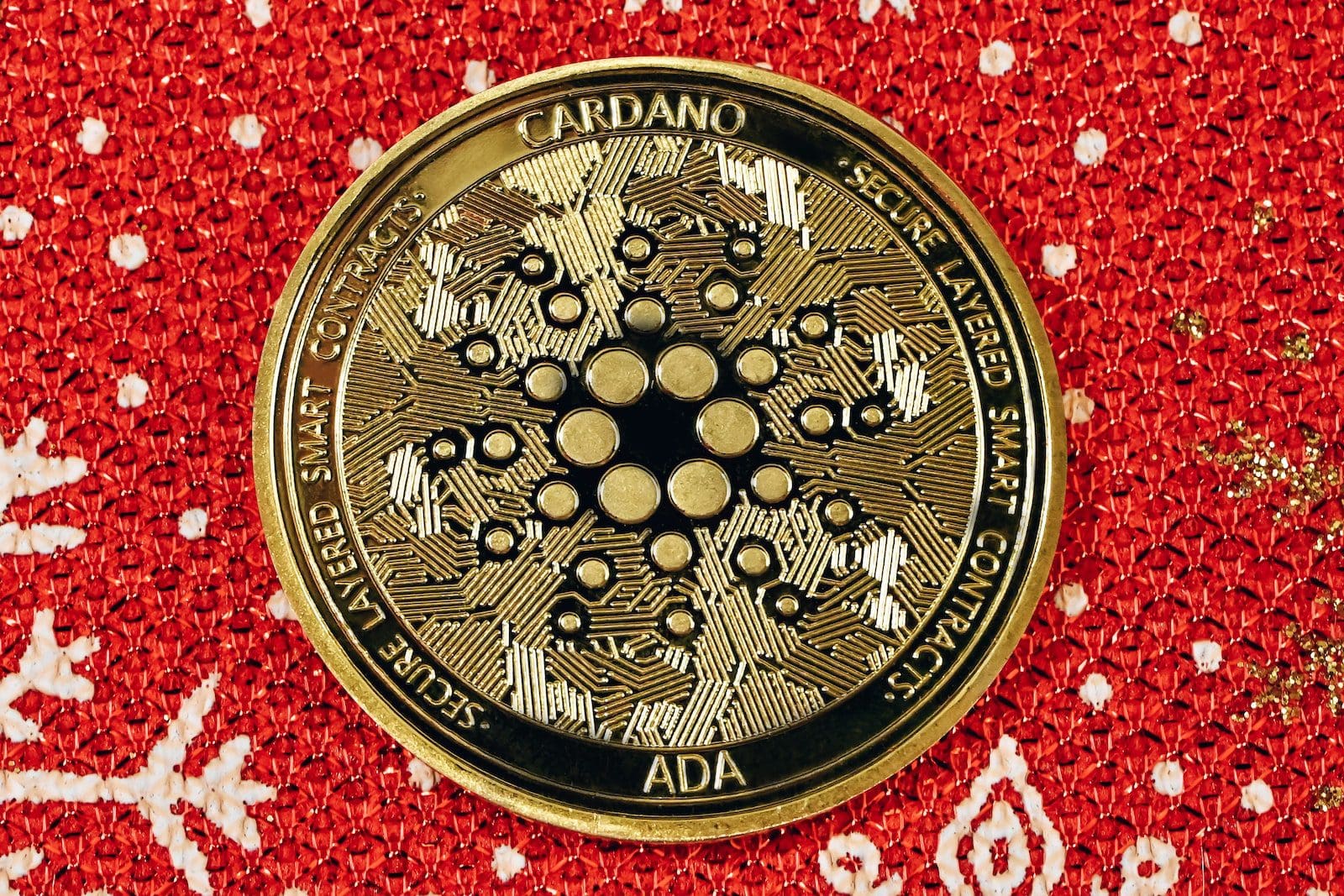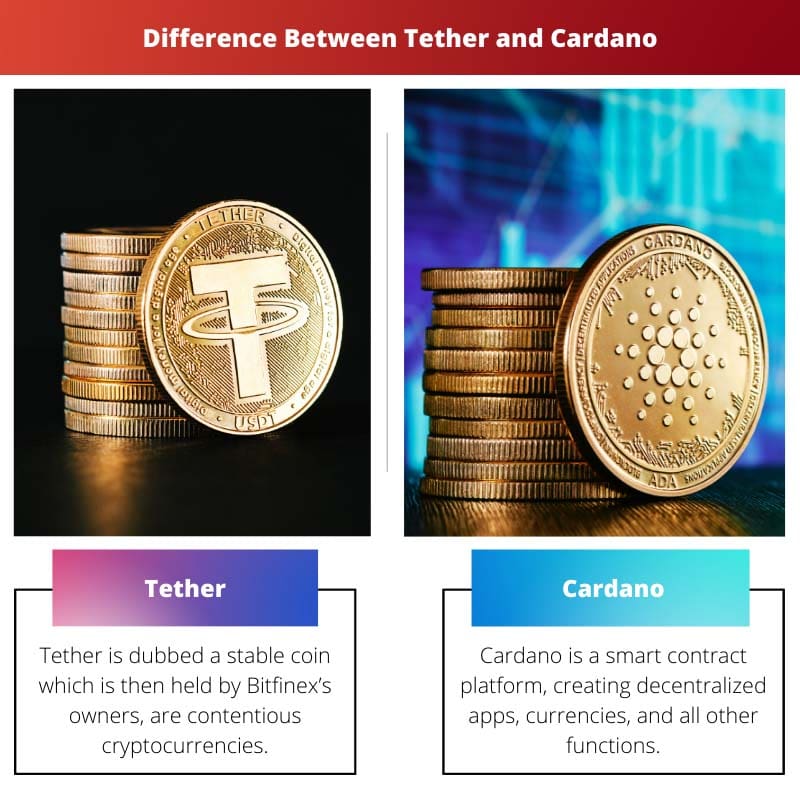Tether (USDT) is a stablecoin pegged to the value of the US dollar, providing price stability and widely used for trading and transferring value. Cardano (ADA) is a blockchain platform known for its focus on scalability, sustainability, and interoperability, aiming to provide a decentralized and secure infrastructure for smart contracts and decentralized applications (DApps).
Key Takeaways
- Tether is a stablecoin pegged to a fiat currency’s value. At the same time, Cardano is a blockchain platform that enables the development and execution of smart contracts and decentralized applications.
- Tether is designed to minimize the volatility of cryptocurrencies, while Cardano aims to provide a more secure and scalable blockchain platform.
- Tether is primarily used to exchange value and hedge against market fluctuations. At the same time, Cardano has the potential to transform various industries by providing a decentralized and transparent platform for conducting transactions and executing contracts.
Tether vs Cardano
Tether is a stablecoin, pegged to the US dollar, designed to maintain a stable value and facilitate fast and secure transactions. Cardano is a blockchain platform that aims to provide a secure infrastructure for the development and execution of decentralized applications (dApps) and smart contracts.

Tether is dubbed a stablecoin because it was initially meant to be $1.00, keeping $1.00 in reserves for each issued tether. The company’s presumable role in influencing the price of bitcoin, its unsure relationship with the Bitfinex exchange, and the inability to provide a promised audit confirming enough reserves in support of the Tether token are controversial. Tether Limited and tether crypto surge are contentious.
Cardano is a smart contract platform creating decentralized apps, currencies, and all other functions that we anticipate of these sorts of projects, which will serve as a blockchain protocol. It appears like a thousand times before Cardano has heard the same pitch, but he has a distinction. This is the first significant system created from the bottom up to provide proof of stakes (PoS).
Comparison Table
| Feature | Tether (USDT) | Cardano (ADA) |
|---|---|---|
| Type | Stablecoin | Proof-of-Stake (PoS) blockchain platform |
| Purpose | Act as a medium of exchange with stable value pegged to the US dollar | Facilitate secure and scalable decentralized applications (dApps) and smart contracts |
| Value | Pegged to the US dollar (1 USDT ≈ $1) | Fluctuating market price |
| Supply | Dynamically adjusts to maintain the peg (currently 83.9 billion USDT) | Limited max supply of 45 billion ADA |
| Transactions | Fast and low-cost | Faster and potentially lower cost than Ethereum |
| Scalability | Highly scalable due to centralized nature | Aims for scalability through layered architecture |
| Security | Relies on centralized reserves and audits | Secured by the Cardano blockchain and its consensus mechanism |
| Use Cases | Primarily used for trading and transferring value | Used for various purposes, including payments, DeFi, and NFT development |
| Regulation | Subject to potential regulatory scrutiny due to centralized aspects | Less susceptible to regulation due to decentralized nature |
What is Tether?
Tether (USDT) is a type of cryptocurrency known as a stablecoin. Launched in 2014, its primary purpose is to maintain a stable value by pegging it to a traditional fiat currency, such as the US dollar. Tether operates on various blockchain networks, including Bitcoin (Omni layer), Ethereum (ERC-20), and others, allowing users to transfer and trade a digital representation of fiat currency.
Stablecoin Mechanism
Tether achieves price stability by backing each token with a reserve of assets, held in bank accounts. This ensures that the total value of issued Tether corresponds to the reserve assets. The 1:1 peg to the US dollar makes Tether a reliable and widely used medium for traders, investors, and individuals seeking to transact in the cryptocurrency space without exposure to high volatility.
Use Cases and Controversies
Tether plays a crucial role in the cryptocurrency market, facilitating quick and stable transfers of value. However, it has faced scrutiny regarding the transparency of its reserves, leading to concerns about its ability to maintain the peg. Despite controversies, Tether remains a significant player in the crypto ecosystem, serving as a bridge between traditional and digital financial systems.

What is Cardano?
Cardano is a third-generation blockchain platform designed to provide a secure and scalable infrastructure for the development of decentralized applications (DApps) and smart contracts. Launched in 2017 by Ethereum co-founder Charles Hoskinson, Cardano aims to address the limitations of existing blockchain networks, focusing on sustainability, interoperability, and scalability.
Key Features of Cardano
- Proof-of-Stake Consensus: Cardano employs a unique proof-of-stake consensus algorithm called Ouroboros. This approach enhances security and energy efficiency by allowing ADA holders to participate in the network’s consensus process, earning rewards for staking their coins.
- Layered Architecture: Cardano’s architecture is divided into two layers – the Cardano Settlement Layer (CSL) for handling transactions and the Cardano Computation Layer (CCL) for executing smart contracts. This separation improves flexibility, security, and scalability.
- Research-Driven Approach: Cardano emphasizes a research-driven methodology, integrating academic research and peer-reviewed studies into its development process. This commitment to scientific rigor aims to ensure the platform’s sustainability and robustness.
- Interoperability: Cardano is designed to facilitate interoperability between different blockchains, allowing seamless communication and value transfer between decentralized networks. This feature enhances Cardano’s potential to become a key player in the broader blockchain ecosystem.
- Sustainability and Governance: Cardano places a strong emphasis on long-term sustainability and decentralized governance. The platform’s treasury system, funded by a portion of transaction fees, supports ongoing development, while its governance model enables the community to participate in decision-making.
- Smart Contracts and DApps: Cardano supports the development of smart contracts and decentralized applications. The platform’s programming language, Plutus, allows developers to create secure and reliable smart contracts, contributing to the growth of the decentralized finance (DeFi) ecosystem on Cardano.
- Scalability: Cardano addresses scalability challenges through its layered architecture and ongoing research initiatives. The platform aims to achieve scalability without compromising security, ensuring that it can handle a growing number of transactions and users.

Main Differences Between Tether and Cardano
- Purpose:
- Tether (USDT): Tether is a stablecoin designed to maintain a 1:1 peg with the US dollar, providing price stability and serving as a widely used digital representation of fiat currency.
- Cardano (ADA): Cardano is a blockchain platform focused on providing a secure and scalable infrastructure for decentralized applications (DApps) and smart contracts, with a goal of advancing the capabilities of blockchain technology.
- Technology and Consensus:
- Tether (USDT): Tether operates on existing blockchain networks, including Ethereum (ERC-20), Omni, and others. It doesn’t have its own consensus mechanism, relying on the consensus of the underlying blockchain.
- Cardano (ADA): Cardano uses a unique proof-of-stake consensus algorithm called Ouroboros. It has its own blockchain and is known for its layered architecture, separating the settlement layer from the computation layer.
- Use Cases:
- Tether (USDT): Tether is primarily used as a stablecoin for trading and transferring value within the cryptocurrency ecosystem. It provides a secure and liquid alternative to fiat currencies for traders and investors.
- Cardano (ADA): Cardano aims to facilitate the development of decentralized applications (DApps) and smart contracts. It has a broader use case, including decentralized finance (DeFi), identity verification, and interoperability between different blockchains.
- Decentralization and Governance:
- Tether (USDT): Tether operates under the umbrella of various blockchain networks, and its governance is influenced by the protocols of the underlying blockchain.
- Cardano (ADA): Cardano emphasizes decentralized governance, involving the community in decision-making processes. It also features a treasury system funded by transaction fees to support ongoing development.
- Innovation and Research:
- Tether (USDT): Tether’s primary innovation lies in providing a stablecoin pegged to fiat currencies, offering a digital representation of traditional currency.
- Cardano (ADA): Cardano is known for its research-driven approach, integrating academic research and peer-reviewed studies into its development. It focuses on sustainability, scalability, and security through ongoing research initiatives.
- Smart Contracts and Development:
- Tether (USDT): Tether does not support smart contracts or decentralized application development. Its primary function is to maintain a stable value.
- Cardano (ADA): Cardano supports the development of smart contracts and decentralized applications through its computation layer. Developers can create secure and reliable smart contracts using the Plutus programming language.





